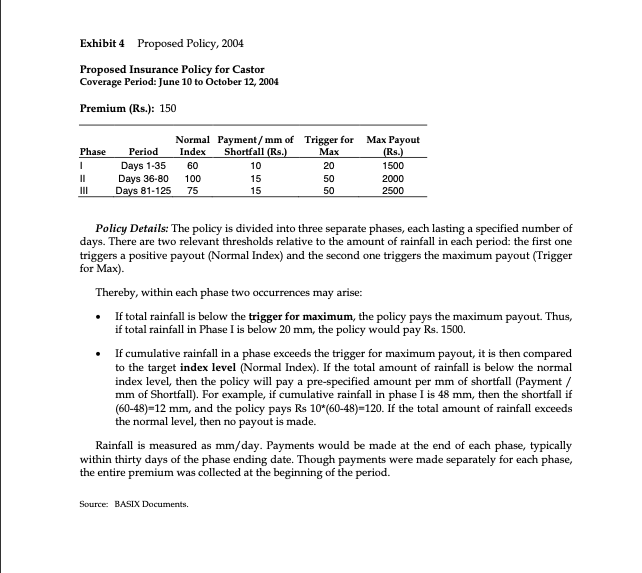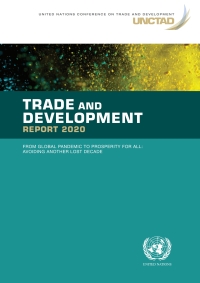Question
Answer the question according to the picture Q 1: Based on your description to me of the revised 2004 product Phase I during our meeting,

Answer the question according to the picture
Q 1: Based on your description to me of the revised 2004 product Phase I during our meeting, last night I sketched out a combination of options that might replicate this payoff scheme: buy 15 put options that each have a strike of 60 mm, sell 15 put options that each have a strike of 20 mm, and buy one binary, all or nothing put with a strike of 20 mm and a payoff of 900 rupees (the binary put pays out 900 rupees if the rain index is strictly below 20, and pays out 0 otherwise). I didnt have much time to check my work.the strike prices of 60 and 20 are obvious, but are the other numbers correct (the 15, 15, and 900)? Please check and let me know (and If not, please correct my work and state to me the correct combination of optionsrewrite the entire strategy, i.e., rewrite the italicized statement above).
Q 2: Similar to Q1, please design an option scheme to replicate the payoffs for Phase II (rewrite the italicized language in Q1 to replicate Phase II).
Q 3: Similar to Q1, please design an option scheme to replicate the payoffs for Phase III (rewrite the italicized language in Q1 to replicate Phase II).
Exhibit 4 Proposed Policy, 2004 Proposed Insurance Policy for Castor Coverage Period: June 10 to October 12, 2004 Premium (Rs.): 150 Max Phase 1 II Normal Payment/mm of Trigger for Max Payout Period Index Shortfall (Rs.) (Rs.) Days 1-35 60 10 20 1500 Days 36-80 100 15 50 2000 Days 81-125 75 15 50 2500 Policy Details: The policy is divided into three separate phases, each lasting a specified number of days. There are two relevant thresholds relative to the amount of rainfall in each period: the first one triggers a positive payout (Normal Index) and the second one triggers the maximum payout (Trigger for Max). Thereby, within each phase two occurrences may arise: If total rainfall is below the trigger for maximum, the policy pays the maximum payout. Thus, if total rainfall in Phase I is below 20 mm, the policy would pay Rs. 1500. If cumulative rainfall in a phase exceeds the trigger for maximum payout, it is then compared to the target index level (Normal Index). If the total amount of rainfall is below the normal index level , then the policy will pay a pre-specified amount per mm of shortfall (Payment / mm of Shortfall). For example, if cumulative rainfall in phase I is 48 mm, then the shortfall if (60-48)=12 mm, and the policy pays Rs 10*(60-48)=120. If the total amount of rainfall exceeds the normal level, then no payout is made. Rainfall is measured as mm/day. Payments would be made at the end of each phase, typically within thirty days of the phase ending date. Though payments were made separately for each phase, the entire premium was collected at the beginning of the period. Source: BASIX Documents. Exhibit 4 Proposed Policy, 2004 Proposed Insurance Policy for Castor Coverage Period: June 10 to October 12, 2004 Premium (Rs.): 150 Max Phase 1 II Normal Payment/mm of Trigger for Max Payout Period Index Shortfall (Rs.) (Rs.) Days 1-35 60 10 20 1500 Days 36-80 100 15 50 2000 Days 81-125 75 15 50 2500 Policy Details: The policy is divided into three separate phases, each lasting a specified number of days. There are two relevant thresholds relative to the amount of rainfall in each period: the first one triggers a positive payout (Normal Index) and the second one triggers the maximum payout (Trigger for Max). Thereby, within each phase two occurrences may arise: If total rainfall is below the trigger for maximum, the policy pays the maximum payout. Thus, if total rainfall in Phase I is below 20 mm, the policy would pay Rs. 1500. If cumulative rainfall in a phase exceeds the trigger for maximum payout, it is then compared to the target index level (Normal Index). If the total amount of rainfall is below the normal index level , then the policy will pay a pre-specified amount per mm of shortfall (Payment / mm of Shortfall). For example, if cumulative rainfall in phase I is 48 mm, then the shortfall if (60-48)=12 mm, and the policy pays Rs 10*(60-48)=120. If the total amount of rainfall exceeds the normal level, then no payout is made. Rainfall is measured as mm/day. Payments would be made at the end of each phase, typically within thirty days of the phase ending date. Though payments were made separately for each phase, the entire premium was collected at the beginning of the period. Source: BASIX DocumentsStep by Step Solution
There are 3 Steps involved in it
Step: 1

Get Instant Access to Expert-Tailored Solutions
See step-by-step solutions with expert insights and AI powered tools for academic success
Step: 2

Step: 3

Ace Your Homework with AI
Get the answers you need in no time with our AI-driven, step-by-step assistance
Get Started


